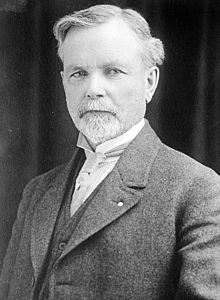Frank M. Byrne
Frank Michael Byrne (born October 23, 1858 in Volney , Allamakee County , Iowa , † December 24, 1928 in San Francisco , California ) was an American politician and from 1913 to 1917 the eighth governor of the state of South Dakota .
Early years and political advancement
Frank Byrne attended local schools in his home in Iowa. In 1879 he moved to the Dakota Territory , where he initially settled in McCook County as a farmer and real estate agent. In 1883 he moved to Faulk County , where he worked as an insurance agent. Byrne was actively involved in creating the new state of South Dakota. In 1888 he was a member of the constituent assembly of the future state. A year later he was a member of the first state senate . He then served as a treasurer in Faulk County for four years.
Politically, Byrne was a member of the Republican Party , whose progressive wing he supported. Between 1907 and 1910 he was again a member of the South Dakota Senate before he was elected lieutenant governor in 1910 . In this capacity he was Deputy Governor Robert S. Vessey between 1911 and 1913 . In 1912 he was elected the new governor.
South Dakota Governor
Byrne took up his new office on January 7, 1913. After a re-election in 1914, he was able to exercise it until January 2, 1917. During those four years a tax commission was formed in South Dakota. In addition, supervisory bodies were set up to oversee banks, insurance companies and railways. The governor also advocated an expansion of the road network in his state in view of the emerging motorized traffic. In 1916 an infantry unit from South Dakota was ordered to the Mexican border. There were border disputes between the United States and Mexico. The unit was brought back in 1917.
Another résumé
After the end of his tenure, Byrne devoted himself first to his private interests. In 1918 an attempt to be elected to the US Senate failed , even in the primary elections of its own party. Between 1922 and 1925, Byrne was Secretary of Agriculture of South Dakota. A rheumatic illness forced him to use crutches. Due to his deteriorating health, he sought relief from his suffering in the better climate of Oregon and then in California. He died in San Francisco on Christmas Eve 1928. He was married to Emmelie Beaver, with whom he had five children.
Web links
- Frank Byrne in the National Governors Association (English)
- Frank M. Byrne in the database of Find a Grave (English)
| personal data | |
|---|---|
| SURNAME | Byrne, Frank M. |
| ALTERNATIVE NAMES | Byrne, Frank Michael (full name) |
| BRIEF DESCRIPTION | American politician |
| DATE OF BIRTH | October 23, 1858 |
| PLACE OF BIRTH | Volney , Iowa |
| DATE OF DEATH | December 24, 1928 |
| Place of death | San Francisco , California |


